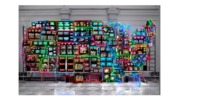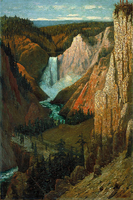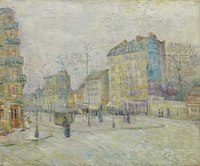Items
Tag
landscape
-
 Electronic Superhighway: Continental U.S., Alaska, Hawaii When Nam June Paik came to the United States in 1964, the interstate highway system was only nine years old, and superhighways offered everyone the freedom to "see the U.S.A. in your Chevrolet." Walking along the entire length of this installation suggests the enormous scale of the nation that confronted the young Korean artist when he arrived. Neon outlines the monitors, recalling the multicolored maps and glowing enticements of motels and restaurants that beckoned Americans to the open road. The different colors remind us that individual states still have distinct identities and cultures, even in today's information age. Paik augmented the flashing images "seen as though from a passing car" with audio clips from The Wizard of Oz, Oklahoma, and other screen gems, suggesting that our picture of America has always been influenced by film and television. Today, the Internet and twenty-four-hour broadcasting tend to homogenize the customs and accents of what was once a more diverse nation. Paik was the first to use the phrase "electronic superhighway," and this installation proposes that electronic media provide us with what we used to leave home to discover. But Electronic Superhighway is real. It is an enormous physical object that occupies a middle ground between the virtual reality of the media and the sprawling country beyond our doors.
Electronic Superhighway: Continental U.S., Alaska, Hawaii When Nam June Paik came to the United States in 1964, the interstate highway system was only nine years old, and superhighways offered everyone the freedom to "see the U.S.A. in your Chevrolet." Walking along the entire length of this installation suggests the enormous scale of the nation that confronted the young Korean artist when he arrived. Neon outlines the monitors, recalling the multicolored maps and glowing enticements of motels and restaurants that beckoned Americans to the open road. The different colors remind us that individual states still have distinct identities and cultures, even in today's information age. Paik augmented the flashing images "seen as though from a passing car" with audio clips from The Wizard of Oz, Oklahoma, and other screen gems, suggesting that our picture of America has always been influenced by film and television. Today, the Internet and twenty-four-hour broadcasting tend to homogenize the customs and accents of what was once a more diverse nation. Paik was the first to use the phrase "electronic superhighway," and this installation proposes that electronic media provide us with what we used to leave home to discover. But Electronic Superhighway is real. It is an enormous physical object that occupies a middle ground between the virtual reality of the media and the sprawling country beyond our doors. -
 View of the Lowe Falls, Grand Canyon of the Yellowstone
View of the Lowe Falls, Grand Canyon of the Yellowstone -
 Boulevard de Clichy "The Boulevard de Clichy is a street in Montmartre, the artists’ neighborhood where Vincent stayed with his brother Theo in Paris, France from March 1886. They lived nearby, first on the Rue de Laval for several months and, from June on, in a larger apartment on the Rue Lepic. The Boulevard played an important role in Van Gogh’s life. The Café du Tambourin and the Moulin Rouge were located here, as was the studio of Fernand Cormon, where he studied for a time. Several of his friends lived here as well: John Russell, Georges Seurat and Paul Signac – the “Impressionistes du Petit Boulevard,” as Vincent referred to them." -Google Arts and Culture
Boulevard de Clichy "The Boulevard de Clichy is a street in Montmartre, the artists’ neighborhood where Vincent stayed with his brother Theo in Paris, France from March 1886. They lived nearby, first on the Rue de Laval for several months and, from June on, in a larger apartment on the Rue Lepic. The Boulevard played an important role in Van Gogh’s life. The Café du Tambourin and the Moulin Rouge were located here, as was the studio of Fernand Cormon, where he studied for a time. Several of his friends lived here as well: John Russell, Georges Seurat and Paul Signac – the “Impressionistes du Petit Boulevard,” as Vincent referred to them." -Google Arts and Culture